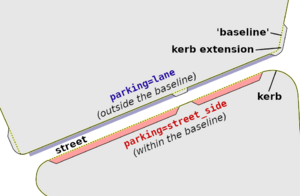User:Supaplex030/street side parking additions
Distinction between street_side and lane parking
Street-side parking bays and areas differ more or less clearly from normal lane parking on the carriageway (parking:side=lane on the street line or parking=lane as separate feature). In general, a street_side parking area is a structural extension at the edge of the carriageway, whereas lane parking is on the carriageway itself.
However, in some cases, a distinction can be difficult and depend on the subjective perception of the mapper. For example, in many places, it is common to extend the kerb at intersections and crossings to slow down traffic and make it safer to cross for pedestrians. Those kerb extensions doesn't make a lane parking of an entire street into a street_side parking. But if there are many kerb extensions in one street, it may become a little hard to distinguish between these two situations in reality.
The following criteria can help to make a classification: they do not have to be fulfilled individually, but can facilitate a categorisation when combined.
Note: When mapping the carriageway width (width=* on the highway line), be aware that the carriageway width includes lane parking areas, but never includes street-side parking areas.
Characteristics indicating street_side parking
| The parking area clearly stands out from the roadway along part of the street through kerbing or other structural elements. | |
| The parking area forms a structural "pocket" and is bordered on its sides by fixed obstacles such as trees, lampposts or bollards. | |
| The parking area is divided into several individual parking "bays" by structural features. | |
| The surface in the parking area is different from that on the carriageway. | |
| The parking area is separated from the carriageway by a kerb. |
Characteristics indicating lane parking
| The parking area could be used as traffic area if no vehicles were parked on it. | |
| The parking area is indicated by installations on the roadway (e.g. bollards), which could, however, be removed without major reconstruction efforts in order to restore the roadway. | |
| The parking area is bordered by structural elements on one side only. | |
| The parking area is bordered only by simple kerb extensions with large distances between them. |
Kerb Extensions
Particularly in combination with kerb extensions (also called "bulb out", "neckdown" and similar), it can be unclear whether a parking area is considered street-side or lane parking. Kerb extensions are traffic calming measures which widens the sidewalk for a short distance to increasing traffic safety for pedestrians.
Kerb extensions are often built into existing road cross-sections. Whether or not this turns a former lane parking into a street-side parking in the OSM sense must be considered in each individual case. The characteristics mentioned above or the following principles can help:
- Large distances between the pavement extensions, the absence of fixed obstacles such as trees, lampposts or bollards as well as an unchanged road surface in the parking area tend to indicate the category of
laneparking. - If, on the other hand, the parking area is divided into rather short sections that are clearly separated from the roadway, this indicates
street_sideparking. - Kerbs form a line that separates the carriageway from the roadside space. Kerb extensions and the parking area in between usually extend out from this "baseline", while street-side parking areas fall behind this "baseline" (see illustration on the right).
Also note the remark above about carriageway width if this is specified at the highway line: For lane parking, the parking area is part of the width value, whereas for street-side parking it's not.
